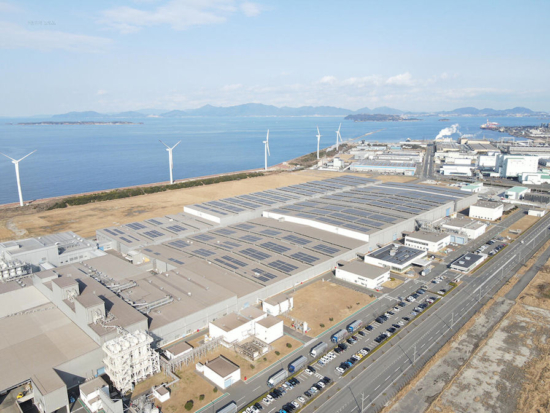Bridgestone: Using the sun to make off-highway tyres
 Electricity generated at the Kitakyushu (pictured) & Shimonoseki sites will power tyre production (Photo: Bridgestone)
Electricity generated at the Kitakyushu (pictured) & Shimonoseki sites will power tyre production (Photo: Bridgestone)
Two Bridgestone tyre manufacturing facilities in Japan are now equipped with solar power systems and are generating electricity under a power purchase agreement. The hardware installed at the plants in Shimonoseki and Kitakyushu has a combined generation capacity of 5.8 megawatts and will supply electricity to produce tyres at the two sites. Bridgestone says replacing electricity from the grid with this power will reduce annual CO2 emissions by around 2,700 tonnes.
Both facilities specialise in the manufacture of tyres for mining and construction vehicles, including products from the Bridgestone MasterCore range. Bridgestone has set the Shimonoseki plant in Yamaguchi Prefecture up to generate 820 MWh annually, which it began doing in October 2022. Bridgestone’s Kitakyushu factory, located on the northernmost tip of Kyushu Island, entered operation this month and can deliver an annual generation volume of 5,250 MWh. In addition to providing solar power, both plants (and Bridgestone’s tyre making facilities in Hikone and Tosu) switched to solely accepting renewable energy from outside suppliers in 2021.
100% renewable electricity by 2030
The approximately 2,700 tonnes of CO2 saved by the estimated 6,070 MWh of solar power generated at the two sites will contribute to Bridgestone Corporation’s goal of reducing absolute CO2 emissions (Scope 1 and 2) by 50 per cent by 2030, compared to 2011. The company additionally seeks to source more than 50 per cent of its electricity from renewable energy by 2023 and has picked up the gauntlet to achieve 100 per cent renewable by 2030.
Bridgestone has transitioned to renewable energy for all electricity purchased at every Bridgestone EMIA location in Europe, the aforementioned four plants in Japan and the Tianjin and Wuxi factories in China. Bridgestone has also begun using solar power at plants in Thailand, the United States, and Europe.





Comments